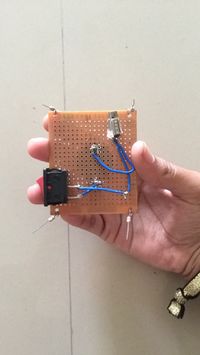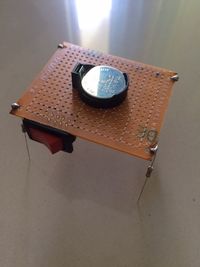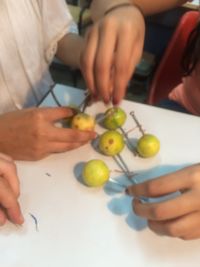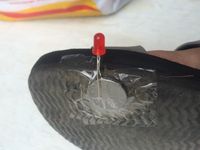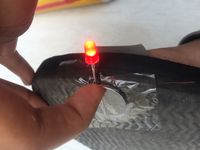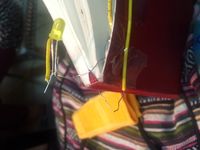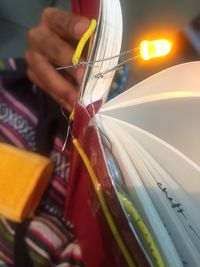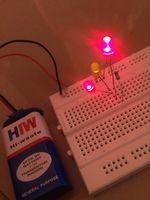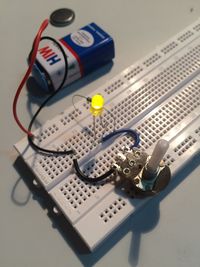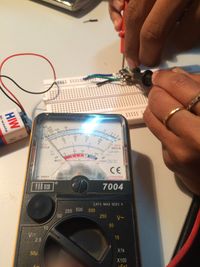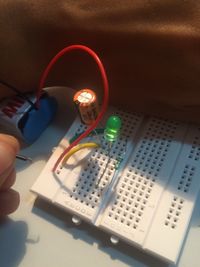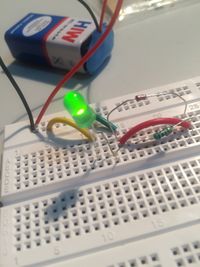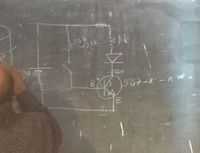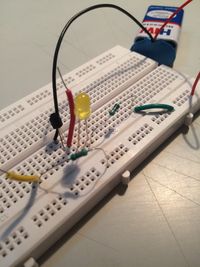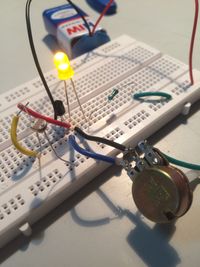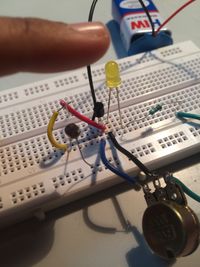Difference between revisions of "Mizba"
| Line 14: | Line 14: | ||
| + | '''Lemon Battery''' | ||
| + | [[File:IMG_3580.jpg|200px|thumb|right|Looking for a certain amount of voltage from lemons to light up an LED]] | ||
| + | This was our first weekend and it was time for our first weekend homework. When I heard that we were to make a battery out of lemons and light up a LED, I was excited as well as tense as to how I was going to make a lemon battery in the first week itself, without any instructions or any knowledge about Electronics. I resorted to YouTube and found that all it took was a big, raw lemon, a copper wire and a nail. I only thought that it was that easy. When I actually tried it, I faced a lot of trouble acquiring enough voltage to light up the LED. When, finally, in class four of us combined our lemon batteries, we finally got very little voltage enough to let the LED glow very dim. | ||
| Line 23: | Line 26: | ||
| − | |||
| − | |||
| − | |||
| Line 36: | Line 36: | ||
| + | '''Switch''' | ||
| + | [[File:IMG_3586.jpg|200px|thumb|left|Switch is Off]] [[File:IMG_3587.jpg|200px|thumb|right|Switch is On]] | ||
| + | [[File:IMG_3603.jpg|200px|thumb|left|Switch is Off]] [[File:IMG_3601.jpg|200px|thumb|right|Switch is On]] | ||
| + | I particularly enjoyed the rate at which the class progressed. Many have complained that it was all going too slow. But on the other hand, I liked the systematic way of teaching in the class. One component per day. Understood well. Especially, for someone like me who needed time to get acquainted with the rules and everything else within the world of electronics. The first component we learnt of was a switch. We all know that a switch, technically, is something that helps us complete any circuit. Now keeping this in mind, we had to make our own switch. We made two types of switches. One, where an LED would light up with pressure put on one loose end of the circuit to sit onto the other end. Basically, we attached this circuit to a slipper, wherein when there is pressure put down by the foot, the LED lights up. The second kind of switch we made was for a book. When the book was opened, the two loose ends of the circuit would meet and thereby, complete the circuit, resulting in the LED lighting up. | ||
| Line 48: | Line 52: | ||
| − | |||
| − | |||
| − | |||
| − | |||
| Line 62: | Line 62: | ||
| + | '''Breadboard and LEDs''' | ||
| + | [[File:IMG_3783.jpg|200px|thumb|left|One LED on Breadboard]] [[File:IMG_3791.jpg|150px|thumb|right|Three LEDs on Breadboard]] | ||
| + | Next, we learned how to use and work on a breadboard. I had never seen a breadboard before, let alone working with one. It took me quite a while to understand how to build circuits on the breadboard. Today, I think breadboards are awesome! I used to see a lot of my classmates work in class like they knew exactly what they were doing and that they already understood what had been explained. I felt out of place for a few days in the beginning because I thought I was the only one who didn't understand too soon. Slowly, I began to cope and my levels of interest rose. The most basic thing to use as an element to understand anything is an LED. Here too, we started with making a very simple circuit by just lighting up an LED. We had to use the 9V batteries for the circuit. Since LEDs cannot sustain 9V, we had to make use of a resistor. When we were good with making the circuit for one LED lighting up we made one with two or three or four LEDs. The basic principle is that an LED has two legs; one longer than the other. The longer leg is connected to ground whereas the shorter leg goes to the positive source. | ||
| Line 69: | Line 72: | ||
| + | '''Potentiometer''' | ||
| + | [[File:IMG_3815.jpg|200px|thumb|right|10K Pot]] | ||
| + | Along with the lighting of the LEDs, we made use of a new component called a ‘Potentiometer’. I was extremely fascinated by the fact that it is a potentiometer used in music systems to increase or reduce the volume. The potentiometer adjusts the resistance in the circuit and this is what helps in the high/low output. | ||
| Line 82: | Line 88: | ||
| − | |||
| − | |||
| − | + | ||
| + | |||
| + | |||
| + | |||
| + | |||
| + | |||
| + | |||
| + | '''Multimeter''' | ||
| + | |||
| + | [[File:IMG_3823.jpg|200px|thumb|right|Using A Multimeter To Measure Resistance]] | ||
| + | |||
| + | A multimeter, I learnt, is a measuring device used to measure different kinds of units, which includes Ohms (for measuring the resistance an object has tooffer), Voltage and electric current. These vary over ranging values and are effective in almost every stage of working with electronics. Normally, there are meters to measure only a particular unit. For example, an Ohmmeter, a Voltmeter, etc. A multimeter is portably convenient as well as does the trick for most jobs. | ||
| + | |||
| + | |||
| + | |||
| + | |||
| + | |||
| + | |||
| + | |||
| + | |||
| + | |||
| + | |||
| + | |||
| + | |||
| + | |||
| + | |||
| + | |||
| + | |||
| + | |||
| + | |||
| + | |||
| + | |||
| + | '''Capacitor''' | ||
| + | |||
| + | [[File:IMG_3846.jpg|200px|thumb|right|LED glows in a broken circuit with the help of a capacitor]] | ||
| + | |||
| + | A capacitor is an extremely useful component. Although, the ones we have used in class were a little lower in capacitating power, I realise that they are very useful in cases where one doesn't need to connect to a power source. The capacitor stores some amount of energy which can be made use of. It is like a power backup. | ||
| + | |||
| + | |||
| + | |||
| + | |||
| + | |||
| + | |||
| + | |||
| + | |||
| + | |||
| + | |||
| + | |||
| + | |||
| + | |||
| + | |||
| + | |||
| + | |||
| + | |||
| + | |||
| + | |||
| + | |||
| + | |||
| + | |||
| + | '''Diode''' | ||
| + | |||
| + | [[File:IMG_3857.jpg|200px|thumb|right|Diode permits the flow of current in the right direction]] | ||
| + | |||
| + | I must’ve studied of a diode in school, but the memory of that learning had completely washed off. The word ‘diode’ sounded familiar, but I had completely forgotten about its function and use. Understanding that a diode marks the flow of current in only one direction is a refreshing experience. I have received so much joy in understanding the littlest of components of electronics.To someone well-acquainted with electronics this kind of excitement may seem unnecessary. But greater joy comes to me when I understand the 1+2+1+3 and not just 7 as a whole. | ||
| + | |||
| + | |||
| + | |||
| + | |||
| + | |||
| + | |||
| + | |||
| + | |||
| + | |||
| + | |||
| + | |||
| + | |||
| + | |||
| + | |||
| + | |||
| + | |||
| + | |||
| + | |||
| + | |||
| + | '''Transistor''' | ||
| + | |||
| + | [[File:IMG_3866.jpg|200px|thumb|left|Circuit diagram for a transistor]] [[File:IMG_3874.jpg|200px|thumb|right|Transistor with a human switch]] | ||
| + | [[File:IMG_3878.jpg|200px|thumb|left|Transistor+LDR+LED+10K Pot]] [[File:IMG_3884.jpg|200px|thumb|right|Shadow on the LDR makes the LED go off]] | ||
| + | |||
| + | To an electronics guy, a transistor was a legendary innovation. I hadn't known the importance of a transistor up until I heard it through Mr. Bala in this class. Uptil until this far, we were only used to working with components that had two legs. Even though the potentiometer has three legs, we made use of only two. A transistor is an amplifier, said Mr. Bala. It amplifiers any given input and gives an output much larger than what it receives. This is known as gain. I tried many variations to a circuit with a transistor. First, I built a circuit with a human switch, wherein, one or two humans can close the circuit by touching the two open ends of the wires jutting out of the circuit. Then, I built a circuit with an LDR and a 10K Potentiometer, wherein, the resistance could be adjusted, as well as, the LDR's reaction to light would affect the LED's performance. That day was very productive, fast-paced and enlightening day. Literally! | ||
| + | |||
| + | '''LDR''' | ||
| + | |||
| + | An LDR is a Light Dependent Resistor. It has a photosensitive surface which reacts to light. So in a circuit with an LED, when the photosensitive surface of the LDR comes in contact with light, the LED goes on immediately. When the source flight is cut off or the LDR is surrounded by darkness, the LED goes off. We also made use of a speaker, in place of/along with the LED in the circuit. Similar to the LED, the speaker also gave sound output with the LDR coming in and out of contact with light. The part where the speaker exercise happened, the entire class went crazy with excitement. Different people had different types of sound output from their speakers. It was interesting to hear all the weird eery sounds the speakers were collaboratively making and most of all, for the first time, a noisy class is was what was expected by everyone, including our facilitators. | ||
Revision as of 23:36, 17 October 2015
My First Robot
Day 1 of Sensors, Probes and Detectors. I was extremely excited. My facilitator, Yashas, only tells us all that we were going to build a robot. And I was a little nervous. I had absolutely no prior know-abouts regarding Electronics, except in school though. What I had studied in school was already hazy and I couldn’t contain my excitement, on day one of this class, in anticipation of learning an entirely new subject. This was my first experience with learning how to solder. Truth be told, mine was the worst kind of soldering in the class. Although, eventually, I got the hang of it and now, I absolutely enjoy using the solder iron. We were only given instructions as to the making of a robot. Honestly, I didn't understand much about what I was doing, but I was only following the instructions. I was the last to finish making my robot, but it was not at all in vain. I took time to understand the logic behind why we did what we did. That was a fulfilling day, alright.
Lemon Battery
This was our first weekend and it was time for our first weekend homework. When I heard that we were to make a battery out of lemons and light up a LED, I was excited as well as tense as to how I was going to make a lemon battery in the first week itself, without any instructions or any knowledge about Electronics. I resorted to YouTube and found that all it took was a big, raw lemon, a copper wire and a nail. I only thought that it was that easy. When I actually tried it, I faced a lot of trouble acquiring enough voltage to light up the LED. When, finally, in class four of us combined our lemon batteries, we finally got very little voltage enough to let the LED glow very dim.
Switch
I particularly enjoyed the rate at which the class progressed. Many have complained that it was all going too slow. But on the other hand, I liked the systematic way of teaching in the class. One component per day. Understood well. Especially, for someone like me who needed time to get acquainted with the rules and everything else within the world of electronics. The first component we learnt of was a switch. We all know that a switch, technically, is something that helps us complete any circuit. Now keeping this in mind, we had to make our own switch. We made two types of switches. One, where an LED would light up with pressure put on one loose end of the circuit to sit onto the other end. Basically, we attached this circuit to a slipper, wherein when there is pressure put down by the foot, the LED lights up. The second kind of switch we made was for a book. When the book was opened, the two loose ends of the circuit would meet and thereby, complete the circuit, resulting in the LED lighting up.
Breadboard and LEDs
Next, we learned how to use and work on a breadboard. I had never seen a breadboard before, let alone working with one. It took me quite a while to understand how to build circuits on the breadboard. Today, I think breadboards are awesome! I used to see a lot of my classmates work in class like they knew exactly what they were doing and that they already understood what had been explained. I felt out of place for a few days in the beginning because I thought I was the only one who didn't understand too soon. Slowly, I began to cope and my levels of interest rose. The most basic thing to use as an element to understand anything is an LED. Here too, we started with making a very simple circuit by just lighting up an LED. We had to use the 9V batteries for the circuit. Since LEDs cannot sustain 9V, we had to make use of a resistor. When we were good with making the circuit for one LED lighting up we made one with two or three or four LEDs. The basic principle is that an LED has two legs; one longer than the other. The longer leg is connected to ground whereas the shorter leg goes to the positive source.
Potentiometer
Along with the lighting of the LEDs, we made use of a new component called a ‘Potentiometer’. I was extremely fascinated by the fact that it is a potentiometer used in music systems to increase or reduce the volume. The potentiometer adjusts the resistance in the circuit and this is what helps in the high/low output.
Multimeter
A multimeter, I learnt, is a measuring device used to measure different kinds of units, which includes Ohms (for measuring the resistance an object has tooffer), Voltage and electric current. These vary over ranging values and are effective in almost every stage of working with electronics. Normally, there are meters to measure only a particular unit. For example, an Ohmmeter, a Voltmeter, etc. A multimeter is portably convenient as well as does the trick for most jobs.
Capacitor
A capacitor is an extremely useful component. Although, the ones we have used in class were a little lower in capacitating power, I realise that they are very useful in cases where one doesn't need to connect to a power source. The capacitor stores some amount of energy which can be made use of. It is like a power backup.
Diode
I must’ve studied of a diode in school, but the memory of that learning had completely washed off. The word ‘diode’ sounded familiar, but I had completely forgotten about its function and use. Understanding that a diode marks the flow of current in only one direction is a refreshing experience. I have received so much joy in understanding the littlest of components of electronics.To someone well-acquainted with electronics this kind of excitement may seem unnecessary. But greater joy comes to me when I understand the 1+2+1+3 and not just 7 as a whole.
Transistor
To an electronics guy, a transistor was a legendary innovation. I hadn't known the importance of a transistor up until I heard it through Mr. Bala in this class. Uptil until this far, we were only used to working with components that had two legs. Even though the potentiometer has three legs, we made use of only two. A transistor is an amplifier, said Mr. Bala. It amplifiers any given input and gives an output much larger than what it receives. This is known as gain. I tried many variations to a circuit with a transistor. First, I built a circuit with a human switch, wherein, one or two humans can close the circuit by touching the two open ends of the wires jutting out of the circuit. Then, I built a circuit with an LDR and a 10K Potentiometer, wherein, the resistance could be adjusted, as well as, the LDR's reaction to light would affect the LED's performance. That day was very productive, fast-paced and enlightening day. Literally!
LDR
An LDR is a Light Dependent Resistor. It has a photosensitive surface which reacts to light. So in a circuit with an LED, when the photosensitive surface of the LDR comes in contact with light, the LED goes on immediately. When the source flight is cut off or the LDR is surrounded by darkness, the LED goes off. We also made use of a speaker, in place of/along with the LED in the circuit. Similar to the LED, the speaker also gave sound output with the LDR coming in and out of contact with light. The part where the speaker exercise happened, the entire class went crazy with excitement. Different people had different types of sound output from their speakers. It was interesting to hear all the weird eery sounds the speakers were collaboratively making and most of all, for the first time, a noisy class is was what was expected by everyone, including our facilitators.
